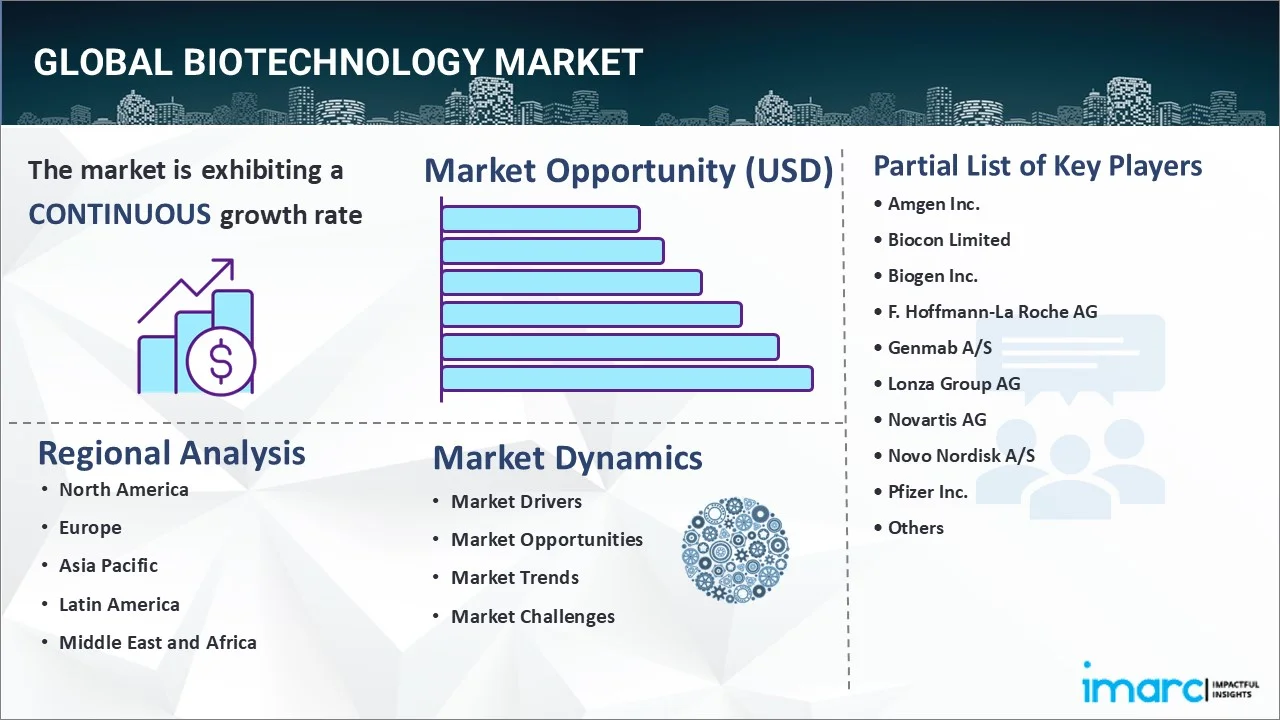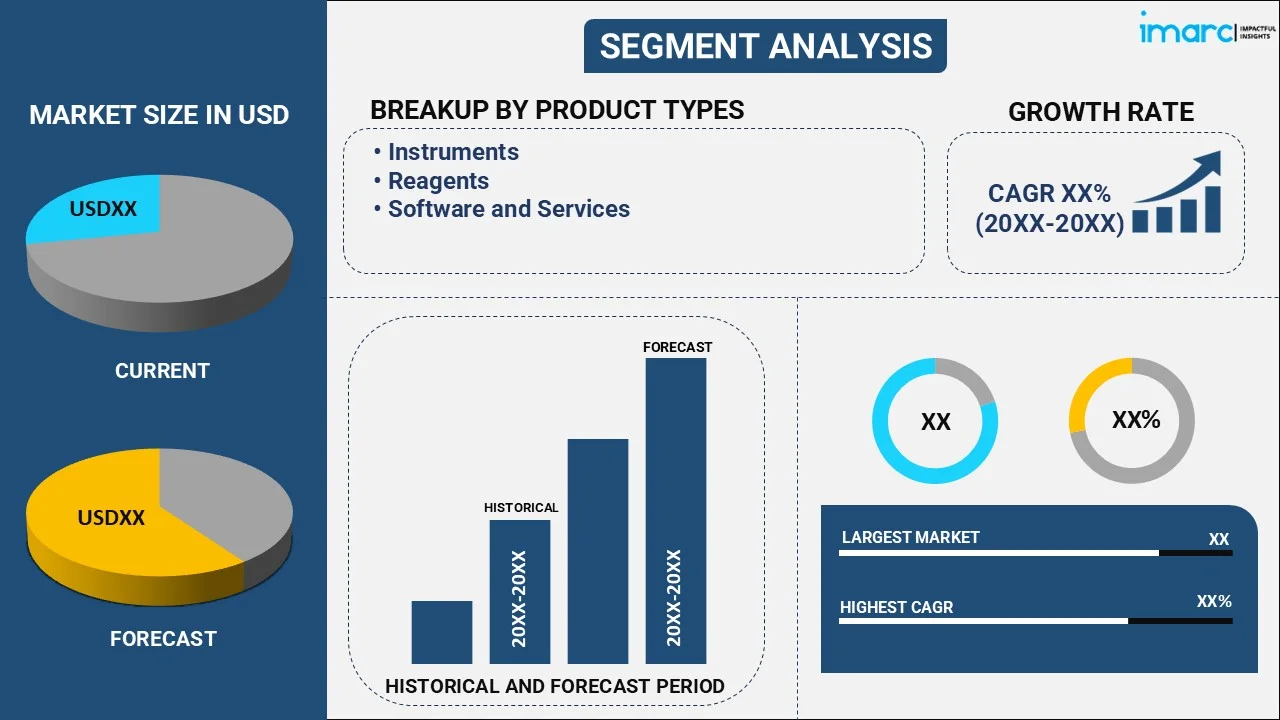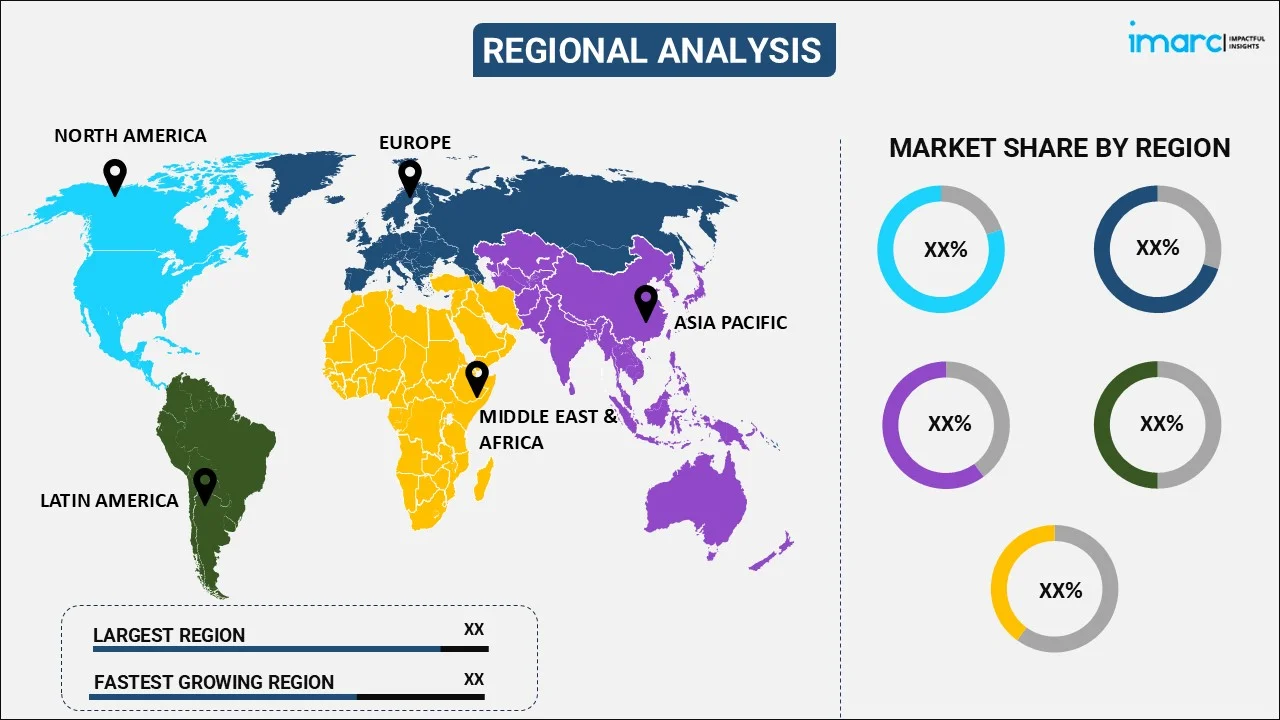
Biotechnology Market Report by Product Type (Instruments, Reagents, Software and Services), Technology (Nanobiotechnology, Tissue Engineering and Regeneration, DNA Sequencing, Cell-Based Assays, Fermentation, PCR Technology, Chromatography, and Others), Application (Healthcare, Food and Agriculture, Natural Resources and Environment, Industrial Processing, Bioinformatics, and Others), and Region 2025-2033
Market Overview:
The global biotechnology market size reached USD 761.5 Billion in 2024. Looking forward, IMARC Group expects the market to reach USD 1,315.9 Billion by 2033, exhibiting a growth rate (CAGR) of 6.27% during 2025-2033. The increasing research and development (R&D) in personalized medicine, numerous advancements in genetic engineering, and escalating demand for sustainable agriculture are some of the major factors propelling the market.
|
Report Attribute
|
Key Statistics
|
|---|---|
|
Base Year
|
2024
|
|
Forecast Years
|
2025-2033
|
|
Historical Years
|
2019-2024
|
|
Market Size in 2024
|
USD 761.5 Billion |
|
Market Forecast in 2033
|
USD 1,315.9 Billion |
| Market Growth Rate (2025-2033) | 6.27% |
Biotechnology is a multidisciplinary field that encompasses the use of living organisms, cells, and biological systems to develop innovative products and technologies. It involves harnessing biological processes and organisms at the molecular and cellular level to address various challenges across industries, such as healthcare, agriculture, and environmental management. Biotechnology includes areas like genetic engineering, biopharmaceuticals, bioinformatics, and synthetic biology, all aimed at creating new solutions, improving existing processes, and advancing our understanding of living systems. This field plays a crucial role in shaping modern medicine, sustainable agriculture, and the development of novel materials for diverse applications.

The rising innovation in areas, including gene editing, personalized medicine, and novel therapies, due to rapid advancements in genetic research and the understanding of molecular biology, will stimulate the market growth during the forecast period. Moreover, the increasing prevalence of chronic diseases and the need for targeted treatments have augmented the demand for biopharmaceuticals and precision medicine, thus positively influencing the market growth. Additionally, the heightening demand for sustainable agricultural solutions owing to the expanding global population and limited arable land has accelerated the adoption of biotechnological techniques in crop improvement and biopesticides. Apart from this, the convergence of biotechnology with information technology, known as bioinformatics, that enhances data-driven insights for research and development is propelling the market growth. Furthermore, the development of bioremediation methods and biofuels on account of the escalating focus on environmental sustainability is contributing to market growth.
Biotechnology Market Trends/Drivers:
Rapid advancements in genetic engineering
The remarkable progress in genetic engineering, prominently exemplified by the revolutionary CRISPR-Cas9 technology, represents a primary driver in the biotechnology market. This technique allows scientists to precisely modify genes within organisms, presenting unprecedented potential for applications in medicine, agriculture, and industrial processes. In healthcare, genetic engineering facilitates the development of innovative gene therapies for genetic disorders and cancers, offering promising avenues for personalized treatments. Moreover, the ability to engineer microbes for the production of valuable compounds like insulin and enzymes has transformed pharmaceutical and industrial manufacturing.
Increasing demand for personalized medicine and therapeutics
The concept of personalized medicine, tailored to an individual's genetic makeup, is gaining traction in the biotechnology market. Advancements in genomic sequencing technologies have made it possible to analyze an individual's genetic code and identify genetic variations linked to diseases. This has led to the development of targeted therapies that address the unique genetic characteristics of patients, enhancing treatment efficacy and reducing adverse effects. Biotechnology enables the production of biopharmaceuticals such as monoclonal antibodies and gene therapies, aligning with the principles of personalized medicine. Additionally, diagnostics based on genetic markers allow for early disease detection and prognosis, reshaping healthcare practices toward more precise and individualized approaches.
Rising need for sustainable agriculture solutions
The increasing global demand for food, coupled with environmental concerns and the need for sustainable agricultural practices, fuels the adoption of biotechnological solutions in farming. Genetically modified crops (GMOs) engineered for enhanced yield, pest resistance, and nutritional content are examples of biotechnology's influence on agriculture. Biopesticides derived from naturally occurring organisms are gaining preference over traditional chemical pesticides owing to their reduced environmental impact. Biotechnology offers tools to optimize plant traits, improve crop resilience to climate change, and increase nutrient efficiency, contributing to food security and resource sustainability. This driver reflects the critical role of biotechnology in addressing pressing challenges within the agriculture sector while minimizing ecological footprints.
Biotechnology Industry Segmentation:
IMARC Group provides an analysis of the key trends in each segment of the global biotechnology market report, along with forecasts at the global, regional and country levels from 2025-2033. Our report has categorized the market based on product type, technology, and application.
Breakup by Product Type:

- Instruments
- Reagents
- Software and Services
The report has provided a detailed breakup and analysis of the market based on the product type. This includes instruments, reagents, and software and services.
Instruments form the foundation of advanced research and diagnostics, enabling precise analysis and experimentation. Reagents are essential components that fuel experimental processes, facilitating accurate results and breakthroughs. Software plays a pivotal role, providing data analysis, visualization, and integration solutions, enhancing efficiency and accuracy in biotechnological endeavors. Services encompass consulting, training, and technical support, nurturing collaboration and aiding in the effective utilization of tools.
Furthermore, these components synergistically push the boundaries of biotechnology, fostering innovation and driving advancements that impact diverse sectors such as healthcare, agriculture, and environmental sciences. As the industry evolves, the strategic interplay of instruments, reagents, software, and services continues to shape the trajectory of biotechnology, fueling growth, discovery, and progress.
Breakup by Technology:
- Nanobiotechnology
- Tissue Engineering and Regeneration
- DNA Sequencing
- Cell-Based Assays
- Fermentation
- PCR Technology
- Chromatography
- Others
A detailed breakup and analysis of the market based on the technology has also been provided in the report. This includes nanobiotechnology, tissue engineering and regeneration, DNA sequencing, cell-based assays, fermentation, PCR technology, chromatography, and others.
Nanobiotechnology integrates nanoscale materials with biological systems, revolutionizing drug delivery, diagnostics, and therapies. Tissue engineering and regeneration pioneers novel approaches for creating functional tissues, addressing organ shortages and medical needs. DNA sequencing enables comprehensive genomic analysis, guiding personalized medicine and disease understanding. Cell-based assays provide insights into cellular behavior, supporting drug development and toxicity testing. Fermentation is a cornerstone for bioprocessing, producing biofuels, pharmaceuticals, and enzymes. PCR Technology amplifies DNA, underpinning diagnostics and genetic research.
Chromatography separates biomolecules with precision, crucial in drug purification and analytical processes. These intertwined advancements drive the market's progress, fostering innovation and solutions across healthcare, agriculture, and environmental sectors.
Breakup by Application:
- Healthcare
- Food and Agriculture
- Natural Resources and Environment
- Industrial Processing
- Bioinformatics
- Others
Healthcare dominates the market
The report has provided a detailed breakup and analysis of the market based on the application. This includes healthcare, food and agriculture, natural resources and environment, industrial processing, bioinformatics, and others. According to the report, healthcare represented the largest segment.
Healthcare serves as a pivotal driving force behind the biotechnology market, catalyzing innovations that transform patient care and medical practices. Biotechnology solutions play a vital role in diagnostics, treatment development, and personalized medicine. From advanced DNA sequencing enabling precise disease identification to biopharmaceuticals revolutionizing treatment modalities, the synergy between healthcare and biotechnology yields breakthrough therapies, improved patient outcomes, and enhanced disease management.
As healthcare and biotechnology intertwine, novel discoveries in areas such as gene editing, synthetic biology, and biomarker development further propelling the market growth. The biotechnology sector's continual evolution addresses current medical challenges and paves the way for future advancements, shaping the landscape of healthcare delivery and underscoring its significance as a critical driver of progress within the biotechnology domain.
Breakup by Region:

- North America
- United States
- Canada
- Asia-Pacific
- China
- Japan
- India
- South Korea
- Australia
- Indonesia
- Others
- Europe
- Germany
- France
- United Kingdom
- Italy
- Spain
- Russia
- Others
- Latin America
- Brazil
- Mexico
- Others
- Middle East and Africa
North America exhibits a clear dominance in the market
The report has also provided a comprehensive analysis of all the major regional markets, which include North America (the United States and Canada); Europe (Germany, France, the United Kingdom, Italy, Spain, Russia, and others); Asia Pacific (China, Japan, India, South Korea, Australia, Indonesia, and others); Latin America (Brazil, Mexico, and others); and the Middle East and Africa. According to the report, North America accounted for the largest market share.
North America held the biggest share in the market since the region boasts a robust ecosystem of research, innovation, and industry collaboration. The region's strong investment in research and development (R&D), coupled with its well-established regulatory frameworks, fosters an environment conducive to biotechnological breakthroughs. Various leading universities, research institutions, and biotech companies converge to push the boundaries of scientific discovery and technological advancements.
Furthermore, the rising emphasis of the North America region on entrepreneurship and venture capital further accelerates the commercialization of novel biotech solutions. With a history of pioneering achievements in areas such as genomics, pharmaceuticals, and medical devices, North America's influential role continues to shape the global biotechnology landscape, catalyzing growth, fostering innovation, and driving positive societal and economic impacts.
Competitive Landscape:
Key players in the biotechnology market have introduced groundbreaking innovations. Leading biopharmaceutical companies are developing mRNA-based vaccines that demonstrated remarkable efficacy in pandemic response. Additionally, advancements in CRISPR-based gene editing techniques have enabled precise and efficient modifications in various organisms, promising transformative applications in genetic therapies and modified crops. Furthermore, the integration of artificial intelligence (AI) and machine learning (ML) in drug discovery and development processes is accelerating the identification of potential drug candidates. These innovations reflect the industry's commitment to addressing global challenges, ranging from disease outbreaks to food security, through cutting-edge biotechnological solutions with the potential to reshape medical treatments, agriculture practices, and industrial processes. We also expect the market to witness new entrants, consolidation of portfolios, and an increase in strategic partnerships and collaborations among vendors to drive healthy competition within the domain during the forecast period.
The report has provided a comprehensive analysis of the competitive landscape in the market. Detailed profiles of all major companies have also been provided. Some of the key players in the market include:
- Amgen Inc.
- Biocon Limited
- Biogen Inc.
- F. Hoffmann-La Roche AG
- Genmab A/S
- Lonza Group AG
- Novartis AG
- Novo Nordisk A/S
- Pfizer Inc.
- Regeneron Pharmaceuticals Inc.
- Seagen Inc.
- Syngenta AG
- Vertex Pharmaceuticals Incorporated
Recent Developments:
- In May 2022, F. Hoffmann-La Roche Ltd, a leading healthcare enterprise headquartered in Switzerland, introduced the innovative breast cancer antibody cocktail drug, PHESGO, to the Indian market. This breakthrough offering comes with a compelling advantage, as it is not only priced at a remarkable 20% lower than existing therapies but also offers a more streamlined and convenient administration process. It specifically targets HER-2 positive breast cancer, a challenging and prevalent subtype, while holding the distinction of being sanctioned for both early and advanced stages, including metastatic cases.
- In January 2021, Novartis AG, a renowned pharmaceutical leader, entered into a strategic collaboration with Alnylam, a pioneering biotechnology company specializing in RNA interference (RNAi) technology. This innovative partnership aims to harness Alnylam's cutting-edge small interfering RNA (siRNA) technology to pave the way for a revolutionary targeted therapy. The focus of this collaboration centers on restoring optimal liver function, a critical aspect in numerous medical conditions.
- In Jan 2023, Pfizer Inc., a global leader in biopharmaceuticals, collaborated with Gero, an avant-garde biotechnology company renowned for its advanced technology platform. This strategic research collaboration marks a convergence of expertise and technology, aiming to unlock new insights into the complex realm of fibrotic diseases. By harnessing Pfizer's extensive domain knowledge and Gero's state-of-the-art machine-learning capabilities, the partnership endeavors to chart unexplored territories in the understanding of genes and pathways linked to fibrosis – a group of disorders characterized by tissue scarring and dysfunction.
Biotechnology Market Report Scope:
| Report Features | Details |
|---|---|
| Base Year of the Analysis | 2024 |
| Historical Period | 2019-2024 |
| Forecast Period | 2025-2033 |
| Units | Billion USD |
| Scope of the Report | Exploration of Historical and Forecast Trends, Industry Catalysts and Challenges, Segment-Wise Historical and Predictive Market Assessment:
|
| Product Types Covered | Instruments, Reagents, Software and Services |
| Technologies Covered | Nanobiotechnology, Tissue Engineering and Regeneration, DNA Sequencing, Cell-Based Assays, Fermentation, PCR Technology, Chromatography, Others |
| Applications Covered | Healthcare, Food and Agriculture, Natural Resources and Environment, Industrial Processing, Bioinformatics, Others |
| Regions Covered | Asia Pacific, Europe, North America, Latin America, Middle East and Africa |
| Countries Covered | United States, Canada, Germany, France, United Kingdom, Italy, Spain, Russia, China, Japan, India, South Korea, Australia, Indonesia, Brazil, Mexico |
| Companies Covered | Amgen Inc., Biocon Limited, Biogen Inc., F. Hoffmann-La Roche AG, Genmab A/S, Lonza Group AG, Novartis AG, Novo Nordisk A/S, Pfizer Inc., Regeneron Pharmaceuticals Inc., Seagen Inc., Syngenta AG, Vertex Pharmaceuticals Incorporated, etc. |
| Customization Scope | 10% Free Customization |
| Post-Sale Analyst Support | 10-12 Weeks |
| Delivery Format | PDF and Excel through Email (We can also provide the editable version of the report in PPT/Word format on special request) |
Key Benefits for Stakeholders:
- IMARC’s report offers a comprehensive quantitative analysis of various market segments, historical and current market trends, market forecasts, and dynamics of the biotechnology market from 2019-2033.
- The research study provides the latest information on the market drivers, challenges, and opportunities in the global biotechnology market.
- The study maps the leading, as well as the fastest-growing, regional markets. It further enables stakeholders to identify the key country-level markets within each region.
- Porter's five forces analysis assist stakeholders in assessing the impact of new entrants, competitive rivalry, supplier power, buyer power, and the threat of substitution. It helps stakeholders to analyze the level of competition within the biotechnology industry and its attractiveness.
- Competitive landscape allows stakeholders to understand their competitive environment and provides an insight into the current positions of key players in the market.
Key Questions Answered in This Report
The biotechnology market was valued at USD 761.5 Billion in 2024.
We expect the global biotechnology market to exhibit a CAGR of 6.27% during 2025-2033.
The rising need for personalized medication, along with the growing adoption of biotechnology sin stem cell research and cloning techniques to replace damaged cells and tissues in regenerative medicines, is primarily driving the global biotechnology market.
The sudden outbreak of the COVID-19 pandemic has led to the increasing demand for biotechnology-based solutions for developing novel drugs and vaccines against the coronavirus infection.
Based on the application, the global biotechnology market can be segmented into healthcare, food and agriculture, natural resources and environment, industrial processing, bioinformatics, and others. Currently, healthcare holds the majority of the total market share.
On a regional level, the market has been classified into North America, Asia-Pacific, Europe, Latin America, and Middle East and Africa, where North America currently dominates the global market.
Some of the major players in the global biotechnology market include Amgen Inc., Biocon Limited, Biogen Inc., F. Hoffmann-La Roche AG, Genmab A/S, Lonza Group AG, Novartis AG, Novo Nordisk A/S, Pfizer Inc., Regeneron Pharmaceuticals Inc., Seagen Inc., Syngenta AG, and Vertex Pharmaceuticals Incorporated.
Need more help?
- Speak to our experienced analysts for insights on the current market scenarios.
- Include additional segments and countries to customize the report as per your requirement.
- Gain an unparalleled competitive advantage in your domain by understanding how to utilize the report and positively impacting your operations and revenue.
- For further assistance, please connect with our analysts.
 Inquire Before Buying
Inquire Before Buying
 Speak to an Analyst
Speak to an Analyst
 Request Brochure
Request Brochure
 Request Customization
Request Customization




.webp)




.webp)












